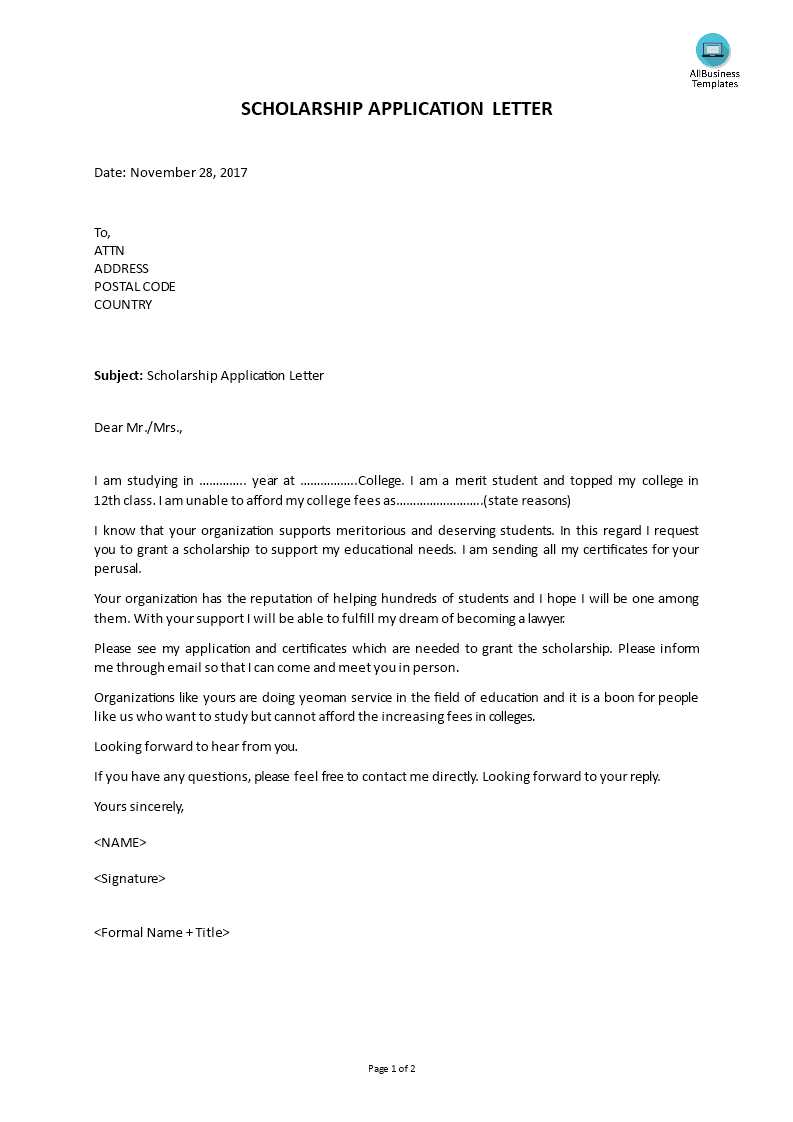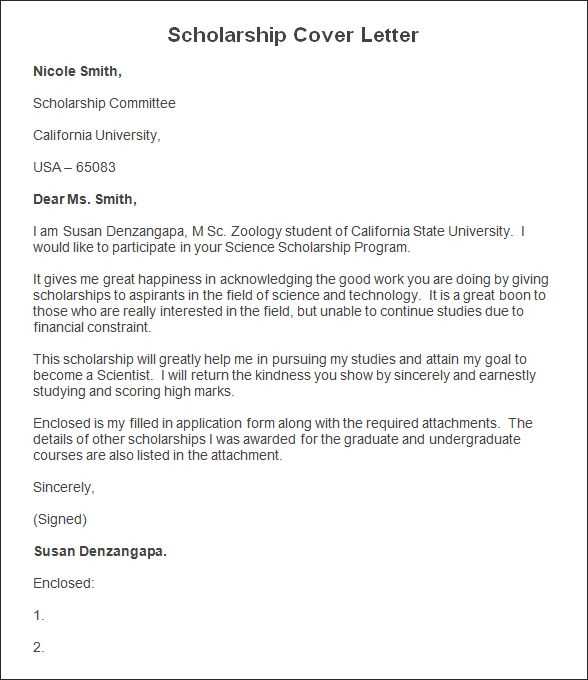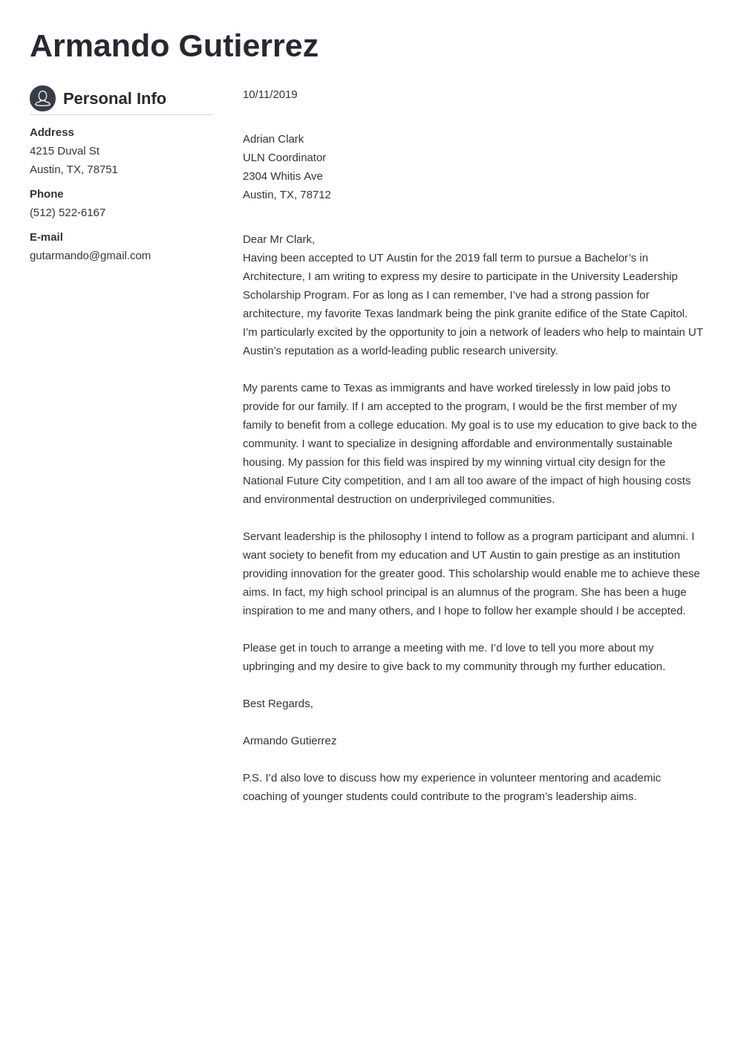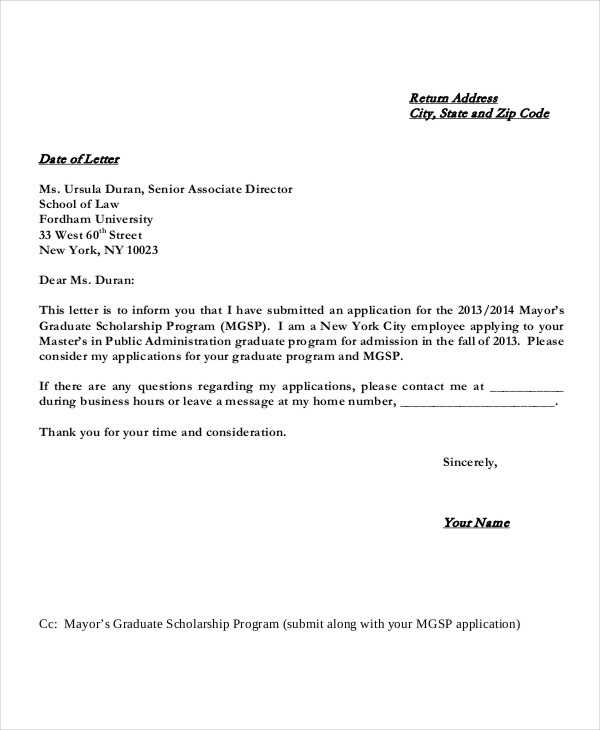Cover letter template for scholarship application

Make your scholarship application stand out by focusing on what sets you apart. A well-written cover letter demonstrates your commitment, passion, and fit for the scholarship, while also showing how you align with the values and goals of the organization offering the opportunity.
Start with a brief introduction that highlights your enthusiasm for the scholarship. Mention the specific scholarship by name and explain why you’re applying. Share a concise statement about your academic or career goals to provide context for your application.
Next, focus on your strengths and achievements that directly relate to the scholarship criteria. Include specific examples of your involvement in relevant projects, leadership roles, or community service. This shows you’ve put thought into how your experiences connect with the scholarship’s mission.
End with a strong closing paragraph that reinforces your gratitude for the opportunity and your eagerness to contribute positively if selected. Express your willingness to provide additional information or materials if needed, and ensure that you thank the reader for their time and consideration.
Cover Letter Template for Scholarship Application
Begin your letter by addressing the scholarship committee directly. Include the full name of the scholarship and mention how you came across it, if applicable. This sets a personal tone right from the start.
Opening Paragraph
Introduce yourself by stating your current academic status, including your major, university, and year of study. Briefly explain why you’re applying for the scholarship and how it aligns with your goals. Make it clear that you’re seeking support to further your education and highlight the specific benefits of this scholarship for your academic journey.
Middle Paragraph(s)
Highlight your achievements, skills, and experiences that make you a strong candidate. Focus on academic accomplishments, relevant extracurricular activities, and any volunteer work that demonstrates your commitment. Be specific about how these experiences have shaped your academic goals. If possible, tie your personal experiences to the mission of the scholarship program or the values it promotes.
Discuss any financial need or challenges that make the scholarship necessary for you. If relevant, mention any unique personal circumstances that may add context to your situation. Keep this section concise but impactful, ensuring it conveys why you deserve the award.
Finish with a strong closing paragraph. Reaffirm your gratitude for being considered and express your enthusiasm for the opportunity. Provide your contact information and offer to supply any additional documents if required. Close with a professional sign-off, such as “Sincerely” or “Best regards.”
Highlighting Your Academic Achievements and Career Goals
Focus on your most relevant academic accomplishments that directly tie to your future career plans. Mention specific courses, projects, or research that have shaped your skills and knowledge. Be clear about how these experiences have prepared you for the scholarship you are applying for and how they align with your professional aspirations.
If you’ve earned awards, scholarships, or recognitions, don’t hesitate to include them. These achievements demonstrate your commitment and ability to succeed. However, don’t list everything–only highlight the accomplishments that best showcase your potential for growth in your chosen field.
Link your academic history with your future career objectives. Make a strong case for why this scholarship will enable you to achieve your goals. Discuss how the financial support will allow you to further your education and provide more opportunities for hands-on experience or advanced studies in your area of interest.
End this section by making a connection between your past work and what you plan to achieve after completing your studies. Show the scholarship committee that you have a clear vision and are actively preparing to contribute to your field. This makes your goals tangible and reflects your commitment to making an impact.
Demonstrating Your Financial Need or Motivation for Applying
Clearly explain why you need financial assistance. Focus on your specific circumstances, such as family income, any personal challenges, or other factors that impact your ability to fund your education. For example, mention if you come from a low-income background, are supporting dependents, or face unexpected financial hardships that make it difficult to afford tuition or living expenses.
If you are applying for a scholarship to pursue a specific career path, connect your motivation to the scholarship’s mission. Show how the scholarship will directly contribute to your ability to reach your goals. Highlight any academic or professional aspirations that align with the values of the scholarship provider. Detail how receiving the scholarship will allow you to focus on your studies or gain experiences that would otherwise be out of reach.
Be transparent and specific. Avoid vague statements. Use concrete examples of your financial need or motivation to clearly demonstrate why this opportunity is crucial for you.
Tailoring the Cover Letter to Match the Scholarship Criteria
Analyze the scholarship guidelines carefully before you start writing. Identify key criteria such as academic achievements, community involvement, leadership, or career aspirations. Make sure your cover letter reflects how your experiences align with these requirements.
Begin by directly addressing the scholarship’s purpose. If the scholarship focuses on community service, emphasize relevant volunteer work. For merit-based scholarships, highlight your academic accomplishments and personal dedication to excellence.
Use specific examples to show how you meet the scholarship’s criteria. For instance, instead of saying you’re passionate about helping others, describe a concrete project where you led an initiative to support a local charity or organized an event for a cause you care about.
Match the tone of your letter to the scholarship’s values. Some scholarships may prioritize leadership skills, while others might emphasize academic potential or personal hardships. Align your language to reflect the scholarship’s priorities without overstating your qualities.
Adjust your writing to the scholarship’s theme. If the scholarship is for a particular field, such as engineering or healthcare, focus on your related experiences or goals. Tailor your aspirations to show that you’re motivated to pursue a career in that area.
| Scholarship Criteria | How to Tailor Your Letter |
|---|---|
| Community Service | Detail specific volunteer experiences and how they reflect your commitment to service. |
| Academic Excellence | Highlight your GPA, honors, or relevant coursework to show your dedication to education. |
| Leadership | Provide examples of times you have taken charge of projects or led a team. |
| Career Aspirations | Link your future career goals to the scholarship’s mission and how it helps you achieve them. |
Be concise and clear while ensuring that every paragraph of your cover letter speaks directly to how you fulfill the scholarship’s criteria. Avoid unnecessary details that don’t add value to your application.
Crafting a Persuasive Closing Statement to Encourage Consideration
End your letter by making a strong, direct appeal that motivates the reader to consider your application favorably. Focus on how the scholarship will help you reach specific academic or career goals, rather than vague statements about needing financial support.
Be Direct and Confident
Clearly state why you’re a strong candidate and how receiving the scholarship will contribute to your future success. Avoid hesitating or being overly modest. Show confidence in your qualifications and potential.
Express Gratitude and Enthusiasm
Thank the committee for their time and consideration. Reiterate your excitement about the opportunity, but do so in a way that highlights your seriousness and commitment to making the most of it.
- Show how the scholarship will help you achieve specific academic or career goals.
- Keep the tone polite, yet assertive and enthusiastic.
- Avoid generic statements or repetition of points already made in the body of the letter.
- Close with a clear statement of your willingness to provide any further information if needed.
Finish with a strong closing line, such as: “I look forward to the opportunity to contribute to [program/field] with the support of your scholarship.” This leaves the reader with a clear sense of your eagerness and commitment.
Proofreading and Formatting Tips for a Polished Cover Letter

Ensure your cover letter is clear and professional by following these proofreading and formatting tips:
1. Correct Common Mistakes

- Check for spelling errors, particularly names, addresses, and technical terms.
- Ensure proper grammar and punctuation throughout the letter.
- Double-check verb tenses to ensure consistency.
2. Improve Readability
- Use a professional font, such as Arial or Times New Roman, in size 10 to 12.
- Keep paragraphs short and concise, limiting each to 3–4 sentences.
- Use bullet points or numbered lists for easy reading of key achievements.
3. Review Your Contact Information
- Verify your contact details are accurate and up to date at the top of the letter.
- Ensure your email address is professional and free of typos.
4. Use White Space Effectively

- Leave enough margin space (1-inch on all sides) to avoid a crowded appearance.
- Separate paragraphs with a single line break for clear visual structure.
5. Adjust Tone and Style
- Maintain a formal, yet approachable tone throughout the letter.
- Avoid using overly complex language or long, convoluted sentences.
6. Read Aloud and Get a Second Opinion
- Read your cover letter aloud to catch awkward phrasing or unclear points.
- Ask someone else to review it for any errors you might have missed.